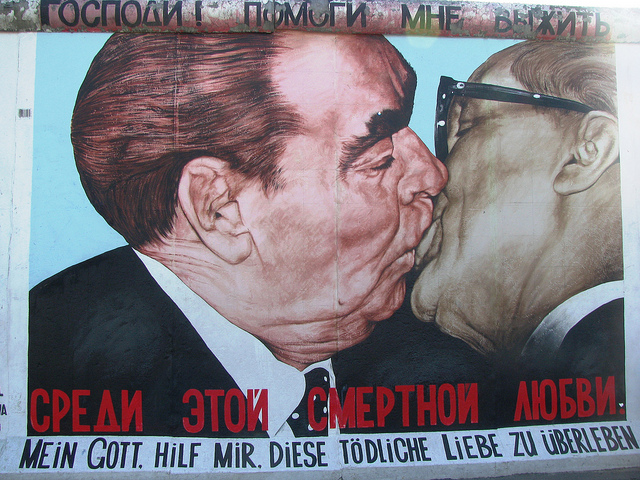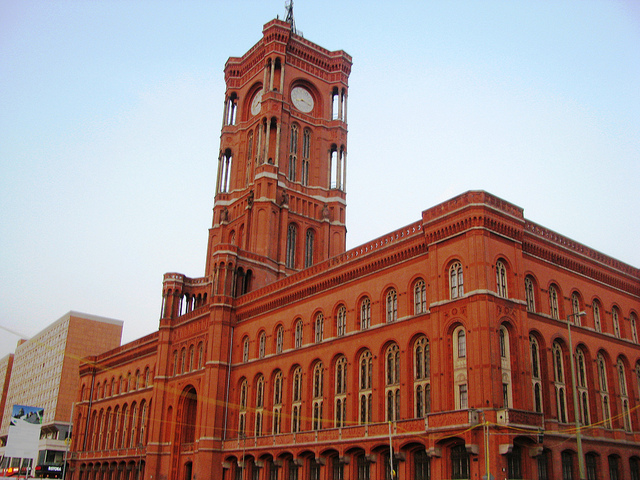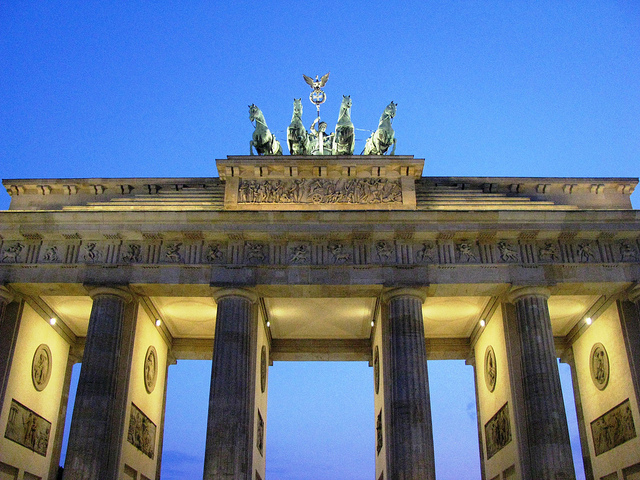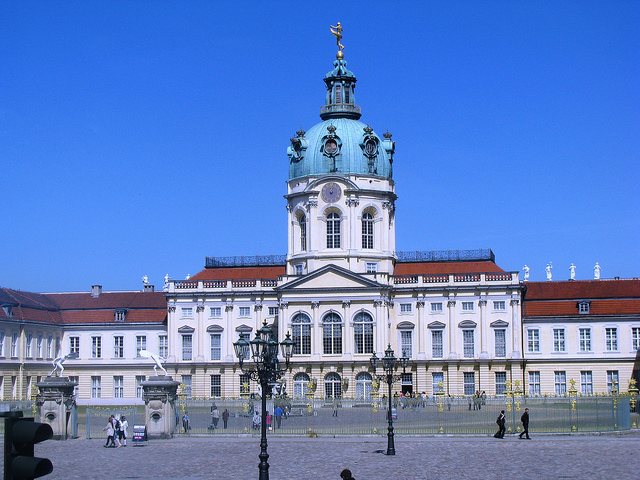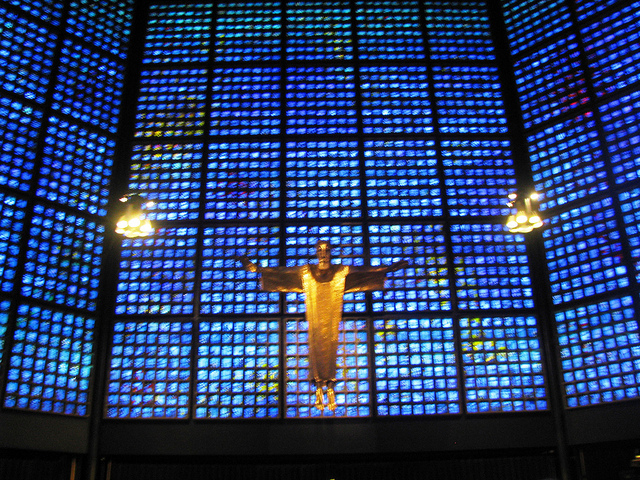Now it was time to explore some of Berlin’s green spaces, so we cycled to the Volkspark Friedrichshain (the Friedrichshain People’s Park), Berlin’s oldest public park and its third largest. The park was originally constructed between 1846 and 1848. During the Second World War, several bunkers and Flak towers were built and made the park a target for Allied bombings. Much of the park lay destroyed after the war and the remainders of the bunkers were filled in and covered by huge amounts of rubble from ruins that were bombed out. About 90% of downtown Berlin was completely obliterated at the end of World War II and the remaining debris was used to construct several artificial hills throughout the city, which today look like completely natural formations.
Today the Volkspark Friedrichshain is a popular recreation area for the city’s residents who enjoy the large meadows, jogging paths, sports facilities, a swan pond, tennis courts and a restaurant. The “Märchenbrunnen” (Fairy Tale Fountain), built in 1913, contains 106 stone sculptures, each representing characters from traditional German fairy tales. It remained virtually unscathed during the war and is still one of the most popular places in the park.

History is everywhere in Berlin, as I learned at our next stop: the beginning of the Karl-Marx Allee, a monument socialist-era-war boulevard that was constructed between 1952 and 1960. It was originally called Stalin-Allee but was renamed in 1961. This avenue is 89 metres wide and two kilometers long and lined by dual towers at each end. Imposing eight-story buildings designed in the socialist “wedding cake” style line the boulevard. Near the Frankfurter Tor, a historic city gate, was the spot where the 1953 Berlin worker uprising took place.
Stefan explained that the socialist government of the time increased work quotas by 10% without a commensurate increase in pay, and when they asked for even greater quota increases, workers from across Berlin gathered to demonstrate against these work norms. Construction workers went on strike and mass demonstrations started to unfold. On June 17, 1953, after tens of thousands of people had gathered in Berlin, Soviet troops entered the city and together with East German security forces, brutally repressed the uprising. It is estimated that more than 500 people were killed, and 106 people were executed under martial law. More than 1800 people were injured and 5100 arrested. About 1200 of these people were sentenced to an average of 5 years in penal camps. 17 or 18 Soviet soldiers were executed for refusing to shoot demonstrators. It was not until the fall 1989 that Berlin would see such civic uprisings again.

Talking about riots, I learned more about civil unrest in Berlin at our next stop, a Turkish restaurant on Boxhagener Square. After a filling lunch we continued to Mainzer Strasse, one of the traditional Berlin locations where riots usually take place. In April of 1990, after the fall of the Berlin Wall, most of the buildings were occupied by local left-wing residents and held for seven months. In November of 1990, the city decided to clear the occupiers and sent about 3000 police officers in. This resulted in a violent clash between the occupiers and police and became one of the factors.
Riots have long been a tradition in Berlin, particularly for May Day or the International Worker’s Day. My expert guide Stefan explained that since 1987, usually every year on April 30 and May 1, there are numerous demonstrations and celebrations by independent workers’ organizations which usually lead to riots by nightfall. Cars are set on fire, shops are looted and burned to the ground and hundreds of people get injured, including police officers. May Day violence was particularly bad in 2010. Thousands of police officers are called to Berlin from other parts of Germany to prevent the worst riots. Even last night, on April 30, riots had taken place in this very street and tiny shards of glass and beer caps were still visible on the cobble-stoned pavement, despite cleanup efforts.
Not far away from Boxhagener Square we stopped at the former train repair sheds at Revaler Strasse. This facility was originally built in 1867 as the main repair facility for the Royal Prussian Railways and remained in operation until 1995. Since then, the area has been taken over by various artists and alternative entrepreneurs and has become home to several dance clubs, the Skatehalle – a favourite place among Berlin skateboarders, an open air cinema, a summer garden with comfortable outdoor seating facilities and a climbing tower. Berlin truly has some very fascinating places that are infused with alternative culture.

Then we continued on to the East Side Gallery, the largest and most well-known remainder of the hated Berlin Wall. With its length of 1316 metres, this is probably the largest and longest lasting open air gallery in the world. In 1990, artists from all over the world painted 105 murals on the Wall. The most famous is a painting of a kiss between former Soviet president Leonid Brezhnev and East German leader Erich Honecker. The inscription underneath the image by Dmitry Wrubel reads “Mein Gott hilf mir diese tödliche Liebe zu überleben” (“My God help me to survive this deadly love”).
While we were admiring the paintings, Stefan explained that we were literally standing in the former “death strip”, the area adjoining the east side of the wall that contained anti-vehicle trenches, fakir beds and other defenses to prevent East German residents from escaping into the West. On the other side of the Spree River was West Berlin, and somebody that experienced an emergency while swimming in the river could not be rescued by the American soldiers on the West side for fear of provoking an international altercation with the Soviets during the Cold War.

Last but not least, we stopped on Alexanderplatz, Berlin’s most famous square. Originally founded as a cattle market, this became Berlins commercial and transportation hub in the late 19th century with the construction of the S-Bahn station. In 1904, the famous Hermann Tietze department store opened on Alexanderplatz, and in 1913 the U2 subway station opened on the square. The 1920s were truly the glory days of the square when it was the hub of Berlin’s nightlife.
World War II brought an end to the glory when all the buildings on the square were virtually obliterated by bombings. It took years to clear away the rubble, and in the 1960s the square was extensively developed with many austere International Style concrete buildings. Berlin’s famous TV Tower, with a height of 368 metres Germany’s tallest structure, was added in 1969 after four years of construction. Since German reunifications more renovations have been taking place. The “Rotes Rathaus” (Red City Hall) is not far away and the historic St. Mary’s Church is around the corner from the square. Despite the severe Socialist-era ambience, the square is a popular gathering place and hosts a lively street market on Saturdays .
After we returned our bicycles at Berlin on Bike, Stefan still gave me a few pieces of advice for places to visit in Berlin. I reflected back on the full day that I had had and all the things that I had learned about this city with my expert guide. This day would definitely become one of the highlights of my trip to Berlin….

